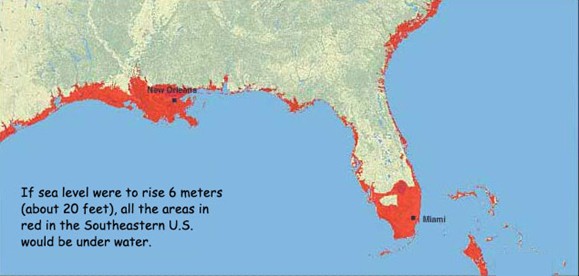In An Inconvenient Truth, the 2006 film that won him an Oscar and a Nobel Prize, former Vice President Al Gore proposed the Greenland ice sheet might melt, causing a 20-foot rise in sea levels. “They can measure this precisely,” Gore claimed, as he showed images of Florida getting devoured by the sea.
A 2007 New York Times report about the film, a 2009 British court ruling, and other sources soon demonstrated the claim to be absurdly exaggerated.
Persistent Myth
But within the carbon alarm movement, the myth of flooding Florida has persisted. A 2015 headline from Climate Central warned: “Coastal Nations, Megacities Face 20 Feet of Sea Rise.”
The World Wildlife Fund website still makes this claim: “Glacial melt of the Greenland ice sheet is a major predictor of future sea level rise; if it melts entirely, global sea levels could rise 20 feet.”
And then there’s the NASA “Climate Kids” page:
If the ice keeps melting, global sea level could rise more than 20 feet. That would put a lot of coastlines under water. Whole islands could disappear!
NASA even added this map, so children on the Gulf Coast could imagine their homes under the waves:

Sea Level plus 20 Feet. Credit: NASA Climate Kids.
And yet, from January 1993 through January 2025, NASA’s satellites have captured a cumulative sea level increase of . . . four inches. The current rate of increase, according to NASA, is 0.17 inches per year.
That’s the thickness of three pennies stacked atop each other.
At that rate of increase, it will take 1,400 years for seas to rise 20 feet. The 35th century is so hard to imagine that it is 300 years beyond the most remote of current Star Trek storylines.
Looking Back
Moving the other direction on the timeline, the Dutch began holding back the ocean 800 years ago and have been improving the engineering ever since. One-third of the Netherlands is already below sea level, some of it 22 feet below.
And while our cars have taken a lot of the blame for rising seas, the seas were steadily rising long before 1908, when Henry Ford rolled out the first mass-produced, gasoline-powered automobile.
An August 2023 entry on the federal government’s Climate.gov reports that “mean sea level has risen about 8–9 inches (21–24 centimeters) since 1880.” Here’s a chart from the Intergovernmental Panel on Climate Change (IPCC) plotting historical sea level increases:

Changes in Global Mean Sea Level. Credit: IPCC Sixth Assessment Report.
Florida’s population has increased by 23 million since 1880, most of them live close to sea level, and nearly two million have arrived just since 2020.
The seas may be rising. But as long as we don’t destroy the prosperity that has allowed us to adapt and move to Florida, this is not an emergency.











